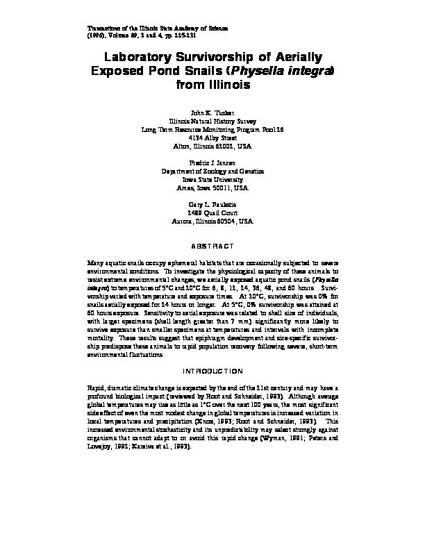
Article
Laboratory Survivorship of Aerially Exposed Pond Snails (Physella integra) from Illinois
Transactions of the Illinois State Academy of Science
Document Type
Article
Disciplines
Publication Version
Published Version
Publication Date
1-1-1996
Abstract
Many aquatic snails occupy ephemeral habitats that are occasionally subjected to severe environmental conditions. To investigate the physiological capacity of these animals to resist extreme environmental changes, we aerially exposed aquatic pond snails (Physella integra) to temperatures of 5°C and 20°C for 6, 8, 12, 24, 36, 48, and 60 hours. Survivorship varied with temperature and exposure times. At 20°C, survivorship was 0% for snails aerially exposed for 24 hours or longer. At 5°C, 0% survivorship was attained at 60 hours exposure. Sensitivity to aerial exposure was related to shell size of individuals, with larger specimens (shell length greater than 7 mm) significantly more likely to survive exposure than smaller specimens at temperatures and intervals with incomplete mortality. These results suggest that epiphragm development and size-specific survivorship predispose these animals to rapid population recovery following severe, short-term environmental fluctuations.
Copyright Owner
Illinois State Academy of Science
Copyright Date
1996
Language
en
File Format
application/pdf
Citation Information
John K. Tucker, Fredric J. Janzen and Gary L. Paukstis. "Laboratory Survivorship of Aerially Exposed Pond Snails (Physella integra) from Illinois" Transactions of the Illinois State Academy of Science Vol. 89 Iss. 3-4 (1996) p. 225 - 231 Available at: http://works.bepress.com/fredric-janzen/38/

This article is from Transactions of the Illinois State Academy of Science 89 (1996): 225. Posted with permission.